Darklordsuperstorm
Member
That would be some low-topped convection by looking at that sounding.
Yes for NC SC. This one's got big ticket potential to our west imoFox Carolina said it's gonna be "much weaker" and "nothing close" to the system today.
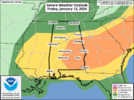
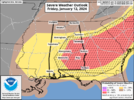
Dryline in jan. Gotta love it. We can’t snow but we sure are good at severeSPC still mentioning a lot of uncertainty for this one. Looks like it has a pretty high ceiling. Still some uncertainty especially with regards to instability. Seems like a lot if the current data is pointing to the possibility of the warm moist air at the surface not being in sync with the area of coldest air aloft. Going to be interesting to see what the mesoscale models start showing today.
Snippet of SPC outlook:
There remains some uncertainty just how expansive of an unstable
warm sector may develop, with perhaps low-level warming and
moistening becoming sufficient for weak boundary-layer
destabilization northeast of the lower Mississippi Valley through
parts of the Tennessee and lower Ohio Valleys during the day.
More substantive low-level moistening seems probable off the north
central/northeastern Gulf of Mexico, into the eastern Gulf through
southern Atlantic Coast states. It appears that this may remain
south of the mid-level cold pool, with relatively warm layers aloft,
even in advance of mid-level subsidence warming nosing
east-northeastward across coastal areas, possibly inhibiting
destabilization.
However, strong to severe thunderstorm development initiating
Thursday night across the southeastern Great Plains into lower
Mississippi Valley may spread east/northeast of the Mississippi
River Friday morning, before perhaps weakening. Thereafter, it
appears that a corridor of stronger surface pressure falls will
develop near the Southeastern Piedmont, from Alabama through the
Carolinas, Friday afternoon into Friday evening. Near the southern
periphery of the mid-level height falls, this might become the
primary focus for organized storm development. Otherwise, models
suggest that a pre-frontal dryline structure may develop across east
central/southeastern Alabama during the mid to late afternoon,
before surging across central Georgia into the Carolinas by late
Friday evening.
Although storm mode remains uncertain, there is concern that this
environment may support and maintain discrete supercell development
with a risk for strong tornadoes. Otherwise, the evolution of at
least a small organized cluster might also be possible, accompanied
by potential for very strong and damaging convective gusts.
New risk areas and probs:View attachment 141092View attachment 141093
Brick?Dryline in jan. Gotta love it. We can’t snow but we sure are good at severe
Tell me about it.Dryline in jan. Gotta love it. We can’t snow but we sure are good at severe
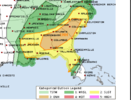
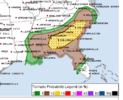
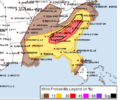
In going to be honest and say I still have no idea why the forecast is so bullish for mby. Like, what am I missing? Cape is basically 0 ..... How discreet supercell with 0 cape?
This setup is far more favorable for discrete activity vs a couple days ago but I like you have a hard time finding much in our area right nowIn going to be honest and say I still have no idea why the forecast is so bullish for mby. Like, what am I missing? Cape is basically 0 ..... How discreet supercell with 0 cape?
Thats how it usually worksNWS Birmingham still says the greatest questions are in regards to the northward progression of the warm sector. It appears clear to them though that wherever that war sector is that it will be an environment supportive of supercells and strong tornadoes.
While there are some
similarities to yesterday`s system in the track of the low, there
are also some important differences. While there will be a
subtropical impulse over the Gulf, it will be located further to
the east towards the Florida peninsula and probably not be a
factor causing disruptive coastal convection. Also the trough will
be further to the north and negatively tilted, in a placement
typically more favorable for supercells in Central Alabama, with
even global models indicating convection being more cellular.
Elevated convection north of the warm front will also be
developing overtop of the CWA rather than south of it. Thus models
are indicating a narrow but relatively robust warm sector with 62
to 65 dew points lifting northward into at least our southern
counties, with around 500 to 1000 J/kg of SBCAPE.
As is typical, shear will be more than sufficient for organized
storms with 0-6km bulk shear values around 90 kts, though it`s
possible that this shear could be too strong if updrafts aren`t
strong enough to avoid being sheared apart. The main question will
be how far north the warm front will lift, especially if it will
lift into the area of strongest forcing, and whether storms willThats
out-run the relatively small warm sector. Will note that while the
500mb shortwave will be lifting quickly northeastward away from
the area by midday, there is still a pronounced 700mb trough to
our west aiding forcing, with some 500mb height falls continuing
through the afternoon. It`s also worth noting that some models may
be veering winds too quickly at the surface given the isobaric
response to the deepening low to our northwest. Overall this is a
low floor but relatively high ceiling event, as any supercell that
is able to remain sustained in the warm sector before crossing to
the cool side of the front would have a conditional threat for a
strong tornado.
This setup is far more favorable for discrete activity vs a couple days ago but I like you have a hard time finding much in our area right now
Their is a massive gap between the floor and ceiling with this eventVery conditional threat, but a volatile one for any storm that takes advantage of the environment could become a long track supercell and produce long tracked tornadoes. There's a narrow window, and also the low pressure itself is expected to deepen very rapidly for a window of time.
This definitely doesn't look like any widespread threat but with dryline like features out ahead of the main cold front itself... Shear is plentiful and SRH are effectively greater than 400 s²/m²..
Yeah tough one to forecast. I feel for SPC. They have to go enhanced because of the ceiling but there's a very plausible scenario where only a few storms get going and people claim bust.Very conditional threat, but a volatile one for any storm that takes advantage of the environment could become a long track supercell and produce long tracked tornadoes. There's a narrow window, and also the low pressure itself is expected to deepen very rapidly for a window of time.
This definitely doesn't look like any widespread threat but with dryline like features out ahead of the main cold front itself... Shear is plentiful and SRH are effectively greater than 400 s²/m²..
Yeah, right now, only individuals I see that are extremely bullish on this event is Reed Timmer, and the SPC to some degree.Their is a massive gap between the floor and ceiling with this event
It's tough to get a good read from Timmer he hypes up everythingYeah, right now, only individuals I see that are extremely bullish on this event is Reed Timmer, and the SPC to some degree.
Guidance isn't of much help, as some are very meager on convective development, some are messy mode, the FV3-1km has some very strong cells in lower SC in the evening but with little SBCAPE.
Tough one to forecast. One to two cells producing multiple tornadoes, and couple strong would verify the ENH risk assessment. Almost feels like this kind of setup.
Yeah the entire sig tor is gone.Big changes View attachment 141423
Sounds good to meYeah the entire sig tor is gone.
Discussion is pretty meh on the whole threat.Yeah the entire sig tor is gone.
